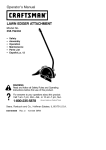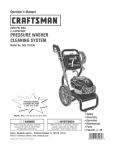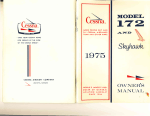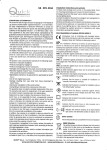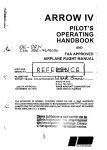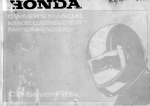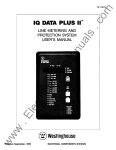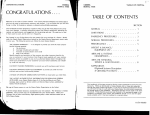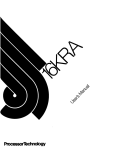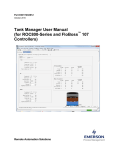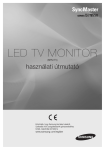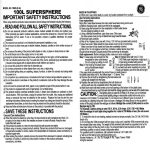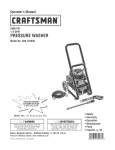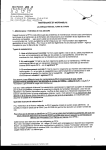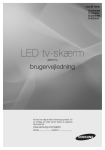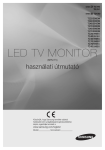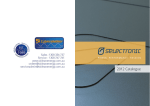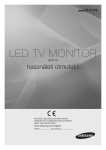Download SECTION B SERVICE & MAINTENANCE
Transcript
CESSNA
}IODEL I72M
SECTION
B
HANDLING, SERVICE
& MAINTENANCE
SECTION B
AIRPLANE HANDLINC,
SERVICE & MAINTENANCE
TABLE OF CONTENTS
Page
Introduction
8-3
8-3
Identification Plate
Owner Follow-Up Systenr
B-3
Publications
8-3
Airplane File
.{irplane Inspection Periods
FAA Required Inspections
Cessna Progressive Care
Cessna Customer Care Progra-m .
Pilot Conducted Preventi\-e lvlaintenance
Alterations or Repairs
8-6
8-6
8-7
8-?
Ground Handling
Towing
8-7
8-4
8-5
B-5
8-?
Parking
Tie-Down
Jacking
8-7
8-8
8-8
Leveling.
Flyable Storage
Servicing
Engine Oil .
Fuel
Landing Gear
Cleaning and Care
Windshield-Windows
Painted Surfaces
Propeller Care
Engine Care
Interior Care
8-9
B-9
8
-10
-10
8
-11
B
8-t2
8-12
8-12
8-12
8-13
8-13
8-14
8-t/ (B-2 blank)
SECTION
CESSNA
8
HANDLING, SERVICE
MODEL 172M
& MAINTENANCE
INTRODUCTION
proper
This section contains factory-recommended procedures for
It also
ground handling and routine cars and servicing of your cessna'
must
requirements^which
maintenance
and
rdentifies certain inspection
and
if yo,rt ui.plane is to retain that new-plane performance and
of
lubrication
planned
sc-hedule
a
follow
to
Cependability. It is wise
encoun-
be followed
and flying conditions
fråventive maintenance basecl on climatic
tered in your localitY.
of his
Keep in touch with Vour cessna Dealer and take advantage
maintain it'
to
how
and
your
airplane
knows
He
i<nowledge and expe.ience.
and
necessary,
are
changes
He will remind yåu when lubrications and oil
periodic
services'
and
about other seasonal
IDENTIFICATIO
N
PLATE
AII correspondence regarding your airplans should include the cerProduction
SERIAL NUMBER. Tne Serial Number, Model Number,
on
:ificate Number (eC) ancl Type Certificate Number (TC) can be found doorforward
left
the
part
of
lower
the
on
:he Identification Plate. localed
and Trim
port. Located adiacent to the Identification Plate is a Finish
plate rvhich contains e code describing the interior color scheme and ex:erior paint combination of the airplane. The code may be used in con- is
,unction with an applicable Parts Catalog if finish and trim information
seeded.
OWNER FOLLOW.UP SYSTEM
your Cessna Dealer has an Orvner Follow-Up System to_ notify you
.rhen he receives infornration that applies to your Cessna' In addition, if
of
;ou wish, you may choose to receive similar notification, in the form
Department'
Service Letters, åirectty from the Cessna Customer Services
book for
Å subscription torm is supplied in your Customer Care Program Dealer
,,.our use, should you choose to reqlest this service. Your Cessna
.r'iII be giad to suppty you ivith details concerning these follow-up programs'
you with fast,
:nd starids reaay, inråugrr his Service Department, to supply
efficient, Iow-cost service.
PUBIICAIIONS
Various publications and flight operation aids are furnished in the
8-3
SECTION
CESSNA
8
MODEL T12M
HANDLING, SERVICE
& MAINTENANCE
airplane when delivered from the
.
.
factory.
These items are listed below.
CUSTOMER CARE PROGRAIVI BOOK
PILCI'S OPERATING HANDBOOK OR SUPPLEMENTS FOR
AIRPIANE
YOUR
AVIONICS AND AUTOPILOT
O
.
POIS/ER COMPUTER
SALES AND SERVICE DEALER DIRECTORY
The following additional publications, plus many other supplies that
are applicable to-your airplane, are available from your Cessna Dealer'
O
SERVICE MANUALS AI'{D PARTS CATALOGS FOR YOI'JR
AIRPLANE
ENGINE AND ACCESSORIES
AVIONICS AND AUTOPILOT
Your cessna Dealer has a customer care supplies catalog covering
items, many of which he keeps on hand. He wiII be happy to
available
aII
place an order for any item which is not in stock'
AIRPLANE
FILE
There are miscellaneous data, information and licenses that are a
part oigt" airplane file. The following is a checklist for that file. In
a peiiodic check should be made of the Iatest Federal Aviation
"ddition,
Regulations to ensure that aII data requirements are met.
A.
To be displayed in the airplane at aII times:
Airworthiness Certificate (FAA Form 8100-2).
Registration Certificate (FAA Form 8050-3),
AircraJt Raåio Station License, if transmitter installed (FCC
(1) Aircraft
iZ) Aircraft
iSi
Form 556).
B.
To be carried in the airplane at all times:
(1) Weight and Balance, and associated papers (Iatest copy
iepair r-na Att""ation Form, FAA Form 33?, if applicable).
(2) Equipment List.
8-4
of the
1r
!
CESSNA
MODEL I72Iv.[
C.
SECTION
8
HANDLING, SERVICE
& MAINTENANCE
To be made available upon request:
(1) Airplane Log Book.
(2) Engine Log Book.
IUR
Most of the items listed are required by the United States Federal
Aviation Regulations. Since the Regulations of other nations may require
rther documents and data. owners of airplanes not registered in the
United States should check with their own aviation officials to determine
their individual requlrements.
Cessna recommends that tlese items, plus the Pilotrs Operating
Handbook, Power Computer, Customer Care Program book and Customer
Care Card, be carried in the airplane at all times.
1
AIR,PLANE INSPECTION PERIODS
tAA REOUIRED INSPEcTIONS
:o
As required by Federal Aviation Regulations, aII civil aircraft of
-. S. registry must undergo a complete inspection (annuat) each twelve
:alendar months. In addition to the required ANNUAL inspection, air:raft operated commercialiy (for hire) must have a complete inspection
:','ery 100 hours of operation.
t
The FAA may require other inspections by the issuance of airworthi:ess directives applicable to the airplane, engine, propeller and compo:ents. It is the responsibility of the owner,/operator to ensure compliance
;:th aII applicable airworthiness directives and, when the inspections are
:epetitive, to tal<e appropriate steps to prevent inadvertent noncompliance.
In lieu of the 100 HOUR and ANNUAL inspection requirements, an
.:.:rplane may be inspected in accordance with a progressive inspection
;:hedule, which allows the work load to be divided into smaller operations
'*:at can be accomplished in shorter time periods.
The CESSNA PROGRESSIVE CARE PROGRAM has been developed to
::ovide a modern progressive inspection schedule that satisfies the com:-ete airplane inspection requirements of both the 100 HOUR and ANNUAL
-.spections as applicable to Cessna airplanes. The program assists the
'å-ner in his responsibility to comply with all FAA inspection requirements,
r.lile ensuring timely replacement of life-Iimited parts and adherence to
i ctory- r e commended inspe ction i ntervals and maintenanc e procedures.
8-5
SECTION
CESSNA
8
MODEL 1?2M
HANDLING, SERVICE
& MAINTENANCE
CESSNA PROGR,ESSIVE CARE
you
The Cessna Frogressive Care Frogram has been designed to help
downand
cost
minimum
a
at
your
aiiplane
realize maximum utilization of
in
time. under this prograrn, your airplane is i_nspected and.maintained
The
operperiod'
200-hour
a
åuring
four operations at-SO-trour intervals
pro-
ations are recycled each 200 hours and are recorded in a specially
vided Aircraft Inspection Log as each operation
is
conducted.
for airThe cessna Ærcraft company recommends Progressive.care
100-hour
the
and
year,
per
more
or
hours
200
flown
planes that are ULi"S
inspection for aII otf,er airplanes. The procedures for the Progressiveout
worked
Care program and the 100-hour inspection hav_e been carefully
The
by the factory and are followed by the Cessna-Dealer Organization' factoryand
equipment
Cessna
with
Dealers
Cessna
complete tamliaritt
possible at
"f
approved p"o""å*eL provides the highest level of service
Iower cost to Cessna owners.
he should
Regardless of the inspection method selected by the owne.r'
part es and FAR Part 91 establishes the requireall required
ment that properly certified agencies or personnel accomplish
inspections'
FAA inspectiorr, ånO most of the manufacturer recommended
keep in"mina that FAR
CESSNA CUSTO'tAER, CARE PROGRA'tA
other
specific benefits and provisions of the CESSNA WARRANTY plusPROCARE
your
cusToMER
in
contained
you
are
important benefits for
airplane. You wiII want to thoroughly reGRAM book supplied *ith yo.tr
-Program
book and keep it in your airplane at
view your Custdmer Care
times.
aII
coupons attached to the Program book entitle you to an-initial inspec100-hour
tion and either p"ogf"ssive CJre Operation No. 1 or the first
charge- to you' If
no
at
"
o*ttu"ship
oi
months
6
first
the
within
inspection
have been
you take AeUvery f"o*-yo"r Dealer, the initial inspection will
If you pick up your airyou.
to
airplane
the
of
delivåry
before
i,å"to"*"d
pt"n" at the factory, plan to take it tå your Dealer reasonably soon after
the
you take aefivery,"so^the initial inspection may be performed allowing
necessary'
be
may
which
bealer to make any minor adjustments
for your
You will also want to return to your Dealer either at 50 hours
100-hour
your
first
for
hours
100
at
first Progressiu" Cr"" Operatior., år
your
inspectioi depending on *tti"ft program you choose to establish for
you by
for
performed
be
will
airplane. White thJse important åtpu.iions
from
Dealer
the
have
to
pre{er
you
wiII
cases
most
in
any cessna Dealer,
work.
this
whom you purchased the airplane accomplish
8-6
SEC
CESSNA
TION
8
HANDLING, SERVICE
& MAINTENANCE
MODEL l1zlvn
PILOT CONDUCTED PREVENTIVE MAINTENANCE
I
l-
A certified pitot who orvns or operates an airplane not used as an air
:arrier is authorized b-v FAR Part 43 to perform limited maintenance on
ris airplane. Refer to FAR Part 43 for a list of the specific maintenance
rperations which are allowed.
NOTE
rr
]t
:y-
-
Pilots operating airplanes of other than U.S. registry
should refer to the regulations of the country of certification for information on preventive maintenance that
may be performed by pilots.
A Service Manual should be obtained prior to performing any preven:ive maintenance to ensure that proper procedures are followed. Your
Cessna Dealer should i-r= :ontacted for further information or for required
:raintenance which mus: be accomplished by appropriately licensed personnel.
d
ed
ATTERATIONS OR REPAIRS
It is essential that the FA.A be contacted prior to any alterations on
åe airplane to ensure that airworthiness of the airplane is not violated.
-\iterations or repairs t: the airplane must be accomplished by licensed
rer
.
.rersonnel.
GROUND HANDLING
TOWING
c|
'
:
le
ilT
hrr
.'å
The airplane is most easily and safely maneuvered by hand with the
:rw-bar attached to the nose rvheel. When towing with a vehicle, do not
:xceed the nose gear turning angle of 30o either side of center, or damage:
:r the gear will result. If the airplane is towed or pushed over a rough
=urface during hangaring, watch that the normal cushioning action of the
:rse strut does not cause excessive vertical movement of the tait and the
:esulting contact with low hangar doors or structure. A flat nose tire or
:eflated strut will also increase tail height.
PAR
KrNG
When parking the airplane, head into the wind and set the parking
rakes. Do not set the parking brakes during cold weather when accumu:ted moisture may freeze the brakes, or when the brakes are overheatedl.
8-?
CESSNA
SECTION 8
MODEL I72M.
HANDLING, SER1TCE
& IVIAINTENANCE
Install the control wheel lock and chock the wheels. In severe weather
and high wind conditions, tie the airptane down as outlined in the following
paragraph.
TIE.DOWN
proper tie-down procedtrre is the best precaution against damage to
the parkåd airplane by gusty or strong winds. To tie-down the airplane
securely, proceed as follows:
(1) Set the parking brake and install the control wheel lock.
(2) Install i surface control lock over the fin and rudder.
(gi Tie sufficiently strong ropes or chains (?00 pounds tensile
strength) to the wingr tail, and nose tie-down fittings and
secure each rope to a ramp tie-down.
(4) Install a pitot tube cover.
JACKING
When a requirement exists to jack the entire airplane off the ground,
or when wing jack points are used in the jacking operation, refer to the
Service Manual
fof specific
procedures and equipment required.
Individual main gear may be jacked by using the jack pad which is
incorporated in the main landing gear strut step bracket. when using
ttre individual gear strut jack pad, flexibility of the gear strut will cause
the main wheel to slide inboard as the wheel is raised, tilting the jack.
The jack must then be lowered for a second jacking operationt D-o not
jack both main wheels simultaneously using the individual main gear jack
pads.
If nose gear maintenance is required, the nose wheel may be raised
off the gfo.tria by pressing down on a tailcone bulkhead, just_forward of the
horizonlal stabiiizer, and allowing the tail to rest on the tail tie-down ring
NOTE
Do not apply pressure on the elevator or outboard stabilizer suifaces. When pushing on the tailcone, always
appty pressure at a br,rlkhead to avoid buckling the skin.
To assist in raising and holding the nose wheel off the ground, weight
down the tail by placing sand-bags, or suitable weights, on each side of
the horizontal ståbilizer, next to the fuselage. If ground anchors are
8-8
SECTION
CESSNA
3.vailable, the
8
HANDLING, SERVICE
MODEL L72I|/'I
& MAINTEI.IANCE
tail should be securely tied
down.
NOTE
will be held off the ground under all
conditions by means of suitable stands or supports under
weight supporting bulkheads near the nose of the airplane.
Ensure that the nose
tEVEtIN'G
Longifudinal leveling of the airplane is accomplished by placing a
-evel on leveling screws located on the left side of the tailcone. Deflate
:he nose tire and/or lower or raise the nose strut to properly center the
:ubble in the level. Corresponding points on both upper door sills may be
.:sed to level the airplane laterally.
FLYABTE SIORAG
l,
E
Airplanes placed in ncn-operational storage for a maximum of 30 days
operational use for the first 25
:l;able storage status. Every seventh day durirg
i:ese periods, the propeller should be rotated by hand through five revolu::lns. This action "Iintbers" the oil and prevents any accumulation of cor-
r thosd which receive rnl',' intermittent
-..lurs are considered in
:
tsion on engine cyiinder walls.
WARNING
:k
rd
the
ring,
For maximum safety, check that the ignition switch is
OFF, the throttle is closed, the mixture control is in
the idle cut-off position, and the airplane is secured
before rotating the propeller by hand. Do not stand
within the arc of the propeller blades while turning the
propeller.
After 30 days, the airplane should be flown for 30 minutes or a ground
:jnup should be made just long enough to produce an oil temperature with.:. thå lower green arc range. Excessive ground runup should be avoided.
rght
lf
Engine runup also helps to eliminate excessive accumulations of water
..-. the fuet system and other air spaces in the engine. Keep fueI tanks fuIl
. minimize condensation in the tanks. Keep the battery fully charged to
::event the electrolyte from freezing in cold weather. If the airplane is
be stored temporarily, or indefinitely, refer to the Service Manual for
: :?per storage procedures.
B-9
SECTION
CESSNA
8
MODEL
IIANDLING, SERVICE
& MAINTENANCE
T?ZI|J'I:
SER,VICING
In addition to the PREFLIGHT INSPECTION covered in section 4,
COMPLETE servicing, inspection, and test requirements for your airp ane are detailed in ihe Service Manual. The Service Manual outlines
all items which require attention at 50, 100, and 200 hour intervals plus
those items which require servicing, inspection, and/or testing at special
intervals.
Since Cessna Dealers conduct all service, inspection, and test procedures in accordance with applicable Service Manuals, it is recommended
that you contact your Cessnå neater concerning these requirements and
begin scheduling your airplane for service at the recommended intervals.
Cessna progressive Care ensures that these requirements are accom-
plished at the re"quirea intervals to comply with the 100-hour or ANNUAL
inspection as previously covered.
Depending on various flight operations, your local Government Avia-
tion Agåncy may require additional service, inspections, or te-sts' For
these i"gniato"y requirements, owners should check with local aviation
officials where the airplane is being operated'
For quick and ready reference, quantities, materials, and specifications for irequently used service items are as follows.
ENGINE OIt
GRADE
Grade sAE 50 Above 16"C (60'F).
Aviation Grade sAE 10W30 or sAE 30 Between -18'C (0'F)
-- Aviation
and 21"C (20"P).
AviationiraAe SAE 10W30 or SAE 20 Below -12"C (10'I).
Multi-vis.oÅily oit *ittt a range of SAE 10W30 is recommended for
improved starling in cold weather. Ashless dispersant oil, conforming to specification No. MIL-L-22851, must be used.
NOTE
Your cessna was delivered from the factory with a corrosion preventive aircraft engine oil. If oil must be
added during the first 25 hours, use only aviation grade
straight mineral oil conforming to specification No. MILL-6082.
CAPACITY OF ENGINE SUMP -- B Quarts.
Do not operate on less than 6 quarts. To minimize loss of oil through
B-10
SECTION
CESSNA
8
HANDLING, SERVICE
& MAINTENANCE
MODEL l72i0/n
breather, fitt to ? quart level for normal flights of less than 3 hours.
For extended flight. titt to B quarts. These quantities refer to oil
dipstick level rådingr. During oil and oil filter changes, one additionat quart is required when the filter element is changed.
mJ
t-
OIL AND OIL FILTER CHANGE -After the first 25 hours of operation, drain engine oil sump arrd oil
cooler and clean borh the oil suction strainer and the oil pressure
screen. If an oil fitter is installed, change filter element at this
time. Refill sump *irh straight mineral oil and use until a total of
50 hours has accun:ul.aled or oil consumption has stabilized; then
change to dispersant oil. On airplanes not equipped with an oil filter,
drain the engine oil sump and oil cooler and clean both the oil suction
strainer and the oil pressure screen each 50 hours thereafter. On
airplanes which have an oii filter, the oil change interrral may be exten-ded to l60-trour rntervals, providing the oil filter element is
changed at 50-hour interrals. Change engine oil at least every 6
months even though iess than the recommended hours have accumuIated. Reduce inier'.ais for prolonged operation in dusty areas, cold
climates, or when short flights and long idle periods result in sludging conditions.
FUEL
,RADE (AND COLORT -- 80/8? Minimum Grade Aviation F\reI (red).
Alternate fuels which are also approved are:
100/130 Low Leaci Å\'GAS (green). (Maximum lead content of 2 cc
per galton. )
iOO/f gO Aviation Grade FueI (green). (Maximum lead content of
4.6 cc per gallon.
)
NOTE
when substituring a higher octane fuel, low lead AVGAS
100 should be used whenever possibte since
it will result
in less lead conLamination of the engine.
-APACITY EACH STANDARD TANK -- 2t Gallons.
IAPACITY EACH LONG RANGE TANK -- 26 Gallons.
NOTE
rugh
To ensure maximum fuel capacity when refueling, place
the fuel selector valve in either LEFT or RIGHT position to prevent cross-feeding.
8-11
SECTION
CESSNA
B
MODEL 1?2M
HANDLING, SERVICE
& IVIAINTENANCE
TANDING
GEAR,
NosEWHEELTIREPRESSURE--31PSIon5.00-5,4.PlyRatedTire.
26 PSI on 6.00-6, 4-PIY Rated Tire'
IVIAINWHEELTIREPRESSURE--29PSIon6.00-6,4-PlyRatedTires'
NOSE GEAR SHOCK STRUT -fluid and inflated with air to
Keep filled *ilt, nnl-H-5606 hydraulic
45 PSL
CLEANING AND
CAR'E
WINDSHIELD-WINDOWS
be cleaned with an aircra^ft
The plastic windshield and windows should
with soft cloths' and rub
windshield cleaner. Apply tnu .i"utl"-spatinglyand bug stains are rewith moderate p"å"t""å^"ntif all dirt, oil scum
with sof t flannel cloths'
moved. Allow lt u .t"uner to A"v, tnån wipe it off
be cleaned
the plastic can
If a windshield cleaner is not available,
soivent to remove oil and grease'
with soft clotns moistened wittr itoadard
NOTE
carbon
Never use gasoline, benzine, alcohol'. acetone'
lacquer
fluid'
anti-ice
o"extinguisite"
fit"
T"irrAffiiåå,
maThese
plastic.
the
clean
to
å"-årår, cleaner
ilrinner
terialswillattacktheplasticandmaycauseittocraze.
Followbycarefullywashingy'itrramilddetergentandplentyofwater.
moist chamois. ?" lfl rub the
Rinse thoroughffinun-a"i*ith " clean
electrosta[Iffifr@which
ptastic with a Jii .iotn silce'this builds up an
wax will finish the cleanattracts dust. waxing with a s*a "o**""ial
ingjob.Athin,evencoato|wa:<polishedout.byhandwithcleansoft
and help prevent further
flannel cloths, will fiII in minor siratches
scratching.
unless freezing rain or
Do not use a canvas cover on the windshield the plastic surface'
scratch
may
ti""e the
"reettåti-iipJJ
"ou""
PAINIED SURFACES
ThepaintedexteriorsurfacesofyournewCessnahaveadurable,
require no polishing or
long lasting finish and, under normal conditions,
the paint to cure comfor
buffing. epproximateiy 15 days are required
been completed prior
have
will
period
cuiing
pletely; in most cases, ttre
or buffing is repolishing
delivery of the airplane. In th"e event that
to
8-12
IA
M
"
SECTION
ESSNA
}IODEL L72M
8
HANDLING, SERVICE
& IVIAI NTENANCE
: iired within the curing period, it is recommended that the work be done
:','someone experienced in handling uncured paint. Any Cessna Dealer
r3n accomplish this work.
Generally, the painted surfaces can be kept bright by washing with
r:.ter and mild soap, followed by a rinse with water and drying with cloths
: a chamois. Harsh or abrasive soaps or detergents which cause corro:.ln or scratches should never be used. Remove stubborn oil and grease
rth a cloth moistened *-ith Stoddard solvent.
Wæring is unnecessar'; to keep the painted surfaces bright, However,
with a good automotive wax. A
".avier coating of wax on the leadirg edges of the wings and tail and on
-'.e engine nose cap and p: -rpeller spinner will help reduce the abrasion
':.countered in these areas.
": desired, the airplane n:a',' be waxed
aJt
ub
ls.
se.
)
ch
n-
When the airplane is parked outside in cold climates and it is neces::ry to remove ice befcre flight. care should be taken to protect the paint': surfaces during ice ren'.i','al with chemical liquids. A 50-50 solution of
;-,propylalcohol and wa:e: *iIl satisfactorily remove ice accumulations
r:ihout damaging the p.::::. A solution with more than 5070 alcohol is
::rmful and should be avrrcied. \\trile applying the de-icing solution, keep
I f,way from the windshield and cabin windows since the alcohol will attack
.-"e plastic and may cause rt to craze.
'IOPEtTER CARE
Preflight inspection cf propeller blades for nicks, and wiping them
::asionally with an oill'cloth to clean off grass and bug stains wiII as' -:e long, trouble-free service. Small nicks on the propeller, particu..:ly near the tips and on the leading edges, should be dressed out as
r .)D ås possible since these nicks produce stress concentrations, and if
;:.cred, may result in cracks. Never use an alkaline cleaner on the
: ,desi remove grease and dirt with carbon tetrachloride or Stoddard
,
lvent.
iNGINE CARE
The engine may be cleaned with Stoddard solvent, or equivalent, then
:::ed thoroughly.
lq_u,m
or
1-
or
Particular care should be given to electrical equipment
before cleaning. Cleaning fluids should not be allowed
to enter magnetos, starter, alternator and the like.
Protect these eomponents before saturating the engine
8- 13
SECTION
8
HANDLING, SERVICE
CESSNA
MODEL T72M
& MAINTEI.IANCE
with solvents. All other openings should also be covered
before cleaning the engine assembly. caustic cleaning
solutions should be used cautiously and should always be
properly neutralized after their use'
INTER,IOR CARE
To remove dust and loose dirt from the upholstery and carpet, clean
the interior regularly with a vacuum cleaner'
Blot up any spilled liquid promptty with cleansing tissue or rags'
press the blotting material firmly and hold it for sevDonrt pat the spotl
-Coniin
ru blotting until no more liquid is taken up. Scrape
eral såconds.
a dull knife, then spot-clean the area'
with
materials
off sticky
Oil spots may be cleaned with household spot removers' used sparnefore rr"ittg any solvent, read the instructions on the container
test
it on an obåcure place on the fabric to be cleaned. Never sahrand
rate the fabric with a volatile solvent; it may damage the padding and
backing materials.
ingly.
soiled upholstery and carpet may be cleaned with foam-type detergent,
used according to thå manufacfurerts instructions. To minimize wetting
the fabric, keep the foam as dry as possible and remove it with a vacuum
cleaner,
If your airpLane is equipped with leather seating,
cleaning of the seats
suds'
is accomplisheå using a sotittottr or sponge dipped in mild soapgrease'
The soapsuds, usediparingly, will remove traces of dirt and
The soap should be removed with a clean damp cloth.
The plastic trim, headliner, instrument panel and control knobs need
only be wlpea off with a damp cloth. Oil and grease on the control wheel
and control t ttoUs can be removed with a cloth moistened with Stoddard
of
solvent. Volatile solvents, such as mentioned in paragraphs on care
plastic'
the
craze
and
they
soften
since
used
be
the windshield, must never
B-14













